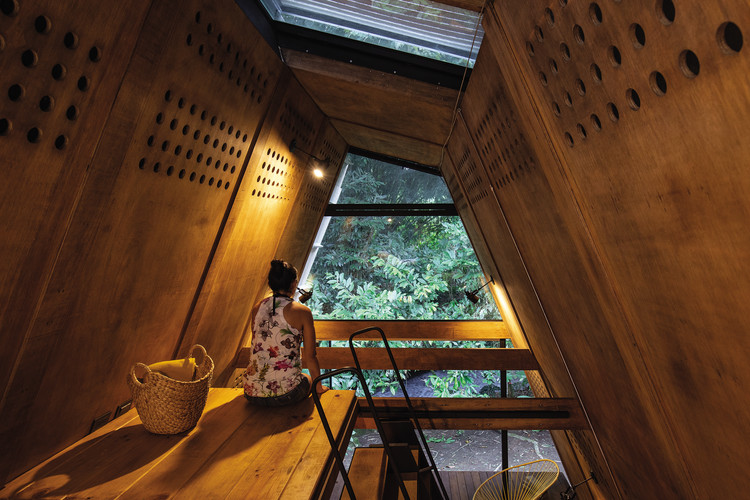
-
Architects: Diana Salvador, Javier Mera Luna
- Area: 40 m²
- Year: 2019
-
Photographs:JAG Studio

"This is a place where you can be naked," the site tells us. HUAIRA sits in front of a small river that roars and seeks the shade of the vegetation to protect itself while joining the landscape.



The mission, a specific need, a refuge outside the city, a contact with the essence of nature. A solution to a problem without generating more. The impact of this construction is scientifically quantified and evidenced in order to create an architecture with a negative carbon footprint.



The more significant design challenges: ventilation in a hot humid climate and a defense mechanism against heavy rain most of the year.



Simple strategies generate local technology; low cost, replicable, adaptable to weather conditions, scalable, modular, expandable and removable technology. The architectural response is simple but not obvious, a "Low Tech" strategy based on the radical decision to use plywood as the basis of this technology.

Wood, stone, metal, glass and tetrapack intervene in a pure and proportional way to consolidate an environmentally balanced element. Each material was assessed by its efficiency and flexibility. Plywood provides structure and containment, tetrapack acts as an umbrella and glass eliminates the barrier between the interior and the exterior.

Bioclimatic strategies based on dynamic thermal simulations were proposed, in order to combine function with interior comfort. The structure was elevated due to the resilience needed to the heavy rain or river flooding, taking advantage of the inertia and the cold air chamber generated under the building. The walls and the roofs form a double layer that contain structural beams and generate another air chamber, guaranteeing the adequate ventilation of the interior space. Floor and wall perforations enable a cross air supply. The removable double layer solution of the roof allows to control direct sunlight without losing the connection with the sky and the environment.


Huaira becomes a constructive system itself, a set of techniques and decisions for a problem that needed to be solved, the sum of multiple simple processes that solve a great complexity. Comparing it with a conventional construction system, Huaira obtains an encouraging result where the carbon footprint is negative, sequestering 3360 kg of carbon and emitting 1679 kg.



The greatest contribution of the Huaira system is to generate local technology by itself and, simultaneously to transform the space into experiences linked with imperceptible details of life.



































